CrimethInc.'s Blog, page 14
August 4, 2013
The Ex-Worker #7: The Rebellion in Brazil

In our seventh episode of the Ex-Worker, CrimethInc’s twice-monthly anarchist podcast, we turn south to focus on the massive rebellions that broke out across Brazil in June. We share excerpts from the in-depth report we published from Brazilian anarchist comrades that traces a timeline of the demonstrations and analyzes their politics, tactics, and influences. There’s also a review of the nihilist journal Attentat, tips on writing to prisoners, feedback from listeners on Guy Fawkes masks and small-town anarchy, and reports on exciting actions happening around the world.
You can download this and all of our previous episodes online. You can also subscribe in iTunes here or just add the feed URL to your podcast player of choice. Rate us on iTunes and let us know what you think, or send us an email to podcast@crimethinc.com. A new episode comes out on the first and third Sunday of every month.
July 27, 2013
The June 2013 Uprisings in Brazil, Part I
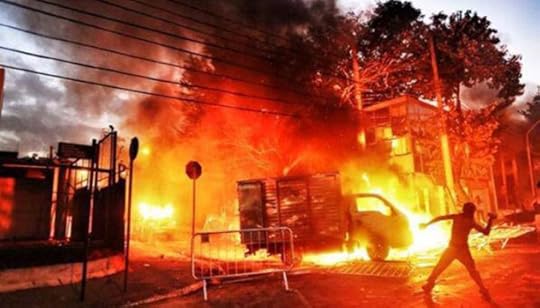
In June 2013, immediately on the heels of the uprising in Turkey, Brazil erupted in nationwide turmoil. Beginning with protests against a public transit fare increase, this upheaval brought hundreds of thousands to the streets in open fighting with the police. The fare increase was soundly defeated, in one of the few victories of the past several years of global revolts. But the movement was a victim of its own success, as middle-class nationalists and pacifists joined in, clashing with other protesters and muddying the issues.
Although anarchists played a decisive role in these events, very little material about the upheaval has appeared in English from Brazilian anarchists. To correct this, we have solicited our comrades’ perspectives from inside the riots. This is the first of two collectively authored texts analyzing the conditions that produced the uprising and the lessons we can draw from it. We will publish the second shortly.
The June 2013 Uprisings in Brazil, Part 1

In June 2013, immediately on the heels of the uprising in Turkey, Brazil erupted in nationwide turmoil. Beginning with protests against a public transit fare increase, this upheaval brought hundreds of thousands to the streets in open fighting with the police. The fare increase was soundly defeated, in one of the few victories of the past several years of global revolts. But the movement was a victim of its own success, as middle-class nationalists and pacifists joined in, clashing with other protesters and muddying the issues.
Although anarchists played a decisive role in these events, very little material about the upheaval has appeared in English from Brazilian anarchists. To correct this, we have solicited our comrades’ perspectives from inside the riots. This is the first of two collectively authored texts analyzing the conditions that produced the uprising and the lessons we can draw from it. We will publish the second shortly.
July 21, 2013
The Ex-Worker #6: Making Police Obsolete

OK, so we’re still not lovin’ the cops—but how do we live without them? In our sixth installment of the Ex-Worker, CrimethInc’s twice-monthly anarchist podcast, we follow up on our last two episodes about prisons and police with a discussion of how to stay safe without the state. We also hear a Croatan Earth First! organizer reporting back from the Round River Rendezvous and the campaign against hydrofracking, review the latest issue of Fifth Estate Magazine, discuss some listener feedback about the politics of anarchist support for the Cuban Five, and share plenty of news and events.
You can download this and all of our previous episodes online. You can
also subscribe in iTunes here or just add the feed URL to your podcast player of choice. Rate us on iTunes and let us know what you think, or send us an email to podcast@crimethinc.com. A new episode comes out on the first and third Sunday of every month.
July 10, 2013
The Ex-Worker, Episode 5: The Police

Putting the “latest” in “latest episode,” we present the fifth installment of our bimonthly podcast, wherein we turn our attention to police and the systematic violence they incarnate. Kristian Williams, author of Our Enemies in Blue, joins us to discuss the development of police tactics since 1968; other special guests include members of East Atlanta Copwatch and a comrade from Çarşı, a Turkish football-ultra group holding it down at Gezi Park in İstanbul. All this is filled out with news from around the world, and a review of “To the Indomitable Hearts: The Prison Letters of Luciano ‘Tortuga’ Pitronello.”
Download the episode or stream it online or read the full transcript. You can also subscribe in iTunes here or add the feed URL to your podcast player of choice. Rate us on iTunes and let us know what you think, or email us at podcast@crimethinc.com. Episodes appear on the first and third Sunday of every month. No, really.
July 9, 2013
The Unist’ot’en Stand Up Against Pipelines
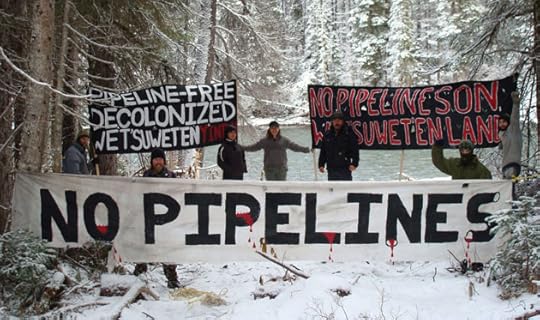
As corporations attempt to enter a new era of even dirtier fossil fuel production, indigenous communities are standing up to take direct action to protect Mother Earth. Some are pursuing legal challenges against violated treaties; others are creating internet-driven mass movements like Idle No More, or reclaiming their roots by going back to the land to assert traditional law. Among the latter are the Unist’ot’en, the People of the Headwater, whose lands encompass a wide swath of Northern British Columbia.
When companies like Enbridge and Apache announced plans to build a massive pipeline corridor through these lands, it provoked outrage from the Wet’suwet’en people whose traditional territory lies directly in its proposed path. Of the five Wet’suwet’en clans, the Unist’ot’en were the first to declare themselves opposed to all pipelines being proposed to cross their traditional territories. Now the Likhts’amisyu, Tsayu, and Git’dum’den clans have followed suit and momentum is growing.
This article tells the story from the perspective of the Unist’ot’en and their allies at the Unist’ot’en Camp through the winter of 2012-3; it has been collectively produced by both indigenous and settler voices. It recounts the development of a common front including the Unist’ot’en and anarchists and other proponents of grassroots resistance, describes the pipeline projects they are intent on thwarting, and explores the complex relationships that have arisen in the course of this struggle.
July 6, 2013
Is S/He an Informant? A Ten Point Checklist

A group of people who have been directly harmed by informant provocateurs have put together this checklist, drawing on personal experiences as well as those of other activists and information from informant provocateurs who have gone public. We hope you can learn from the damage that has already been done, so these people can be stopped before they are able to harm you.
Here are ten warning signs:
1.
Something feels “off.” Something about them just doesn’t line up. Their stories about their activist history or life history, don’t ring true. At this point, you need to run a background and criminal check. If you wait for all the other signs, it may be too late. The most obvious cause for serious concern is when someone shows up in an activist community and they don’t seem to have existed prior to that. That should be a dealbreaker right off the bat.
2.
Despite the misgivings of some members, the individual quickly rises to a leadership position. S/he eagerly takes credit for actions in the media and begins to promote him/herself. S/he works to become one of the “faces” of the organization, and clearly wants to be a poster child for the group, attempting to “brand” their identity with the group’s name, imagery, and identity. S/he likes getting photographed, even when engaged in illegal activity.
3.
S/he photographs actions, meetings, and people that should not be photographed. S/he posts photos of actions and meetings on social media sites like Facebook, even tagging activists without their permission (in effect, facilitating law enforcement surveillance).
4.
S/he is a liar. S/he shows signs of lacking ethics and lacking transparency with the rest of the group.
5.
S/he advocates for high-risk illegal action to people s/he should not trust, while claiming to understand the importance of security culture. S/he goads others to violent action, for example by telling them they need to be “warriors.” Upon reflection, the illegal actions in question often have no real purpose and will not advance the goals of the group in any meaningful way. The person generally has a very twisted perception of what it means to be a warrior.
S/he seeks internal rifts in the community and exploits them. S/he has a cycle of abuse with groups and individuals: a honeymoon period, followed by manipulative, abusive behavior, followed by apologies and promises to do better. Then the cycle repeats.
6.
S/he always has bail money and pocket money, but either no real job, or no job that pays that much. S/he may imply access to a trust fund or similar resources, but this needs to be checked. S/he somehow has the financial freedom to be at any action that will get media attention, or any underground action that may involve illegal activity.
7.
S/he is found to be lying about really serious things like identity, family, background, race, or ethnicity.
8.
S/he has warrants but is unafraid of announcing and advocating illegal action, using his/her real name, publicly advertising his/her whereabouts, and once again jumping into the frame whenever photos or video are being taken at illegal actions. When picked up, s/he always makes bail and gets released, sometimes released on Own Recognizance even when the charges are very serious. This happens a lot. Then the individual goes right back to meetings, taking photos and posing for photo ops. S/he has a Catch and Release cycle with the cops. S/he may have a history of very early release from prison, then going directly to political meetings, sometimes of groups s/he privately claims to hate, or that would have been forbidden as a condition of normal parole.
9.
Juicy information, given only to the suspected informant, comes out the law enforcement end. To be sure this is taking place, the information must be unmistakable, and have been shared face to face, one on one, with zero possibility of surveillance (say, whispered in the informant’s ear in the middle of a field).
10.
Full admission: “My name is ________ and I was employed by [agency] to infiltrate [organization].” A full admission of informant and/or provocateur status may include details of what the informant provocateur received in exchange for their work: either the amount of money they were paid, or the deal they got to be released from prison or avoid prosecution for particular crimes. In some cases, the deal includes a future position with the law enforcement or intelligence agency that hired them. On the unlikely chance that someone is mentally ill, this information could conceivably be checked against the going rate for informant provocateurs; but if the other criteria are met, assume they are telling you the truth, even if they are mentally ill. While mentally ill people do not make reliable informants, they can make excellent provocateurs, and their history of instability can be cited as evidence when law enforcement denies the individual was hired as a provocateur.
If a person meets any of the criteria beyond points 1 through 3, you shouldn’t be working with them. Hopefully, all the points beyond number one will not even matter, as you will have already cut ties with the person after the first red flag. Regardless of whether we can prove someone is an infiltrator, if they display any of the problematic behavior described here, they shouldn’t be party to anything sensitive in the first place. Even if they’re not an infiltrator yet, it offers reason to believe they could be turned or crack under interrogation.
Here are some other warning signs to watch for. When it comes to people’s daily behavior, outside of meetings and actions, is the suspicious person behaving inappropriately with children? Are they harming their partners? Can they not keep their hands off kids? Or are they trying to sleep with multiple adults in the group (or one of the leaders)? Make sure you don’t have a pedophile who was let free in exchange for disruption, or a serial rapist or woman beater who has been turned loose on an activist community to cause devastation. Note when such people never face consequences from law enforcement, even when the victims press charges. If there’s a solid case against a predator, and that predator is allowed to flee, then goes to political meetings in another jurisdiction while the feds refuse to extradite him for trial… bingo.
In our recent experience, a predator who met nine out of ten of the above criteria (including number ten: an admission to other activists he was trying to turn) was never convicted by law enforcement. Instead, he was turned loose on a series of activist communities, wreaking havoc and destruction. Only his death put a stop to it. But there are plenty just like him, eager to take his place. Some of them may be on your friends list on Facebook. Some may have literally gotten away with murder.
When it comes to the thorny question of agents provocateurs and direct action, the point is not whether violence or nonviolence is preferable, but whether someone has violated the consensus of their affinity group and put their team in danger without their consent. It is irresponsible to allege that violence is always the work of agents provocateurs; rather, agents provocateurs set out to instigate violence that will be disadvantageous or isolating for the participants.
Here’s an example. Someone who has met all the above criteria except numbers nine and ten shows up at a public march. The march has been planned as a peaceful, legal event. Perhaps not all actions by this group are peaceful and legal, but for this event, that is the agreed strategy. The event is covered by the media, people are using their real names, and elders and children are participating. The provocateur has spent months ingratiating himself into the group, showing up for every action, paying the bills, giving people rides, saying whatever they want to hear, even buying them drugs. But once the march is underway and the cameras are rolling, the provocateur proceeds to show no regard for the safety or consensus of his group. He does whatever he can to shift the mood of the crowd, to instigate and encourage high emotions. The conditions are tense, and the provocateur does what he can to encourage breaks with discipline, and violations of the conditions previously agreed to. Suddenly he strikes out with a small but significant action, say of property damage or violence toward an individual, providing the flashpoint for sudden escalation. Then, as others follow suit, and illegal and dangerous actions erupt in front of the cameras, the provocateur fades back into the crowd, his mission accomplished. He has now put vulnerable and unprepared members of the community into direct danger, leaving them to handle the consequences of his actions while once again he goes free.
Check videos of actions on YouTube. Some people have filmed themselves breaking the law at actions. Some videos include this flashpoint moment. Note who does this over and over. Note who is and isn’t arrested for these things, and who does and doesn’t do time.
Successful agents can be hard to spot. But most infiltrators are not trained law enforcement officers. Most are criminals who have been cut a deal if they simply go to meetings and listen, or if they go to meetings and actions and disrupt.
In our experience, there have been a bare few, but significant, cases in which activists have been mistaken in their suspicions. In one case long ago that affected many of us, this misidentification had devastating consequences. The mistake was due to a lack of evidence and experience on the part of those who made the misidentification and a lack of solid criteria with which to evaluate the situation–not to mention the participation of actual agents in scapegoating an innocent woman. But because of this serious mistake, many activists compounded that mistake by swinging to the other extreme, overlooking blatant red flags and even direct admissions of infiltrator status. By providing this checklist, we aim to help you to develop your ability to identify, and prioritize, the truth in these situations. It’s not “bad jacketing” when it’s true.
There are a number of guidelines and articles out there about security culture. But just because a group has posted links or statements about the need for security culture doesn’t mean everyone in that group is paying attention and practicing security culture properly. We recommend this text to people and hope that this checklist will be a helpful addition.
Be safe, be effective, and trust your gut.
July 4, 2013
Interview: Anarchists in the Turkish Uprising
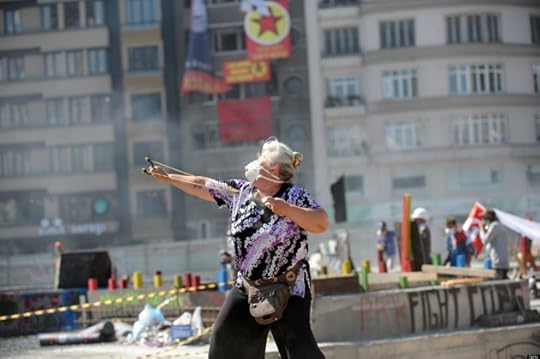
To follow up our coverage of the uprising in Turkey beginning from Taksim Square, we’ve conducted an interview with anarchists in İstanbul. They talk about the background of the revolt, the relationship between this uprising and others around the world, and its implications for the future of Turkey.
What preexisting organizations have played a role in this new explosion of social struggle?
The important thing about this rebellion is that there was no political organization leading the movement. No leader, no party. The explosion appeared on the third day of the protests about the park and trees. People went to the streets because of the violence and brutality of poliçe—that is, the violence of the state. There were also some other motivations driving people into the streets, but none of them is related to any political organization. It is an autonomous movement.
What tactics have been most important in the conflicts? Where did those tactics originally develop? How did they spread?
Although there is no political organization directing people, there are anarchists, leftists, and other people who were already organized. It is important to have experience in clashes; individuals from these political groups talk with the others about how to act in the streets, and everybody decides what to do. There were some important initiatives—like building barricades, and behind them people who supported the effort with first aid, cooking, and discussing what to do next. People were eager to talk more about what to do. This is a new thing here. Information was shared via fliers on the street and via social media about how to keep up with the movements of the police, how to respond to the gas bombs, and the rights of people who are arrested. I have to admit that people used Facebook and twitter in a useful way.
Compare the beginning of the Taksim Square occupation with previous protests, such as the demonstrations of May Day 2013. In both cases, who were the organizers, and what were their original goals? Why did the Taksim Square occupation in particular spark so much new participation?
OK, we have to clarify the starting point of the protests. This year has been the most repressive year yet for the social opposition. The government banned demonstrators from the square for May Day. That was the starting point, I think. There were also clashes on May Day. And after May Day, we are not allowed to protest anything in Taksim. The government banned any kind of demonstration. So this made people angry. We were on streets after May Day to protest various things, but mainly this situation.
The new thing about this occupation is not about demands or ideas. The new thing is the reaction of the people who saw the violence of the state. Before the rebellion, things like “barricades,” “gas masks,” and “throwing stones at the police” seemed like bad notions for the people. This has changed a lot. Now the people are cheering for tear gas and singing songs about the barricades.
How have the Greek social struggles since December 2008 shaped the imaginations of people in Turkey? What about the recent uprisings in North Africa, and the Occupy movement in the US?
I think there are some similarities between the 2008 rebellion in Greece and 2013 in Turkey. There are some economic facts in both cases, but these are not the real reasons. The situations are, rather, the expressions of the people against the terror and violence of the state. When the police murdered Alexis [Grigoropoulos], the situation changed. The legitimacy of the state disappeared. People understood the real purpose of the state. This is the situation in Turkey now. The legitimacy of the state has disappeared.
The events of 2008 in Greece attracted the attention of anarchists in Turkey. There were solidarity actions (in which we were directly involved). It gave us an opportunity to talk about anarchism with the people. I don’t know if this had any role in self-organizing our society. But at least I can say this: the rebels in Greece shaped the imagination of anarchists in Turkey.
After 2008, another rebellion occurred in Greece in 2010. We attribute more importance to this rebellion, because it was then that anarchists especially started to organize life and shape its context. This is important for anarchism and also for society as a whole. All analyses will be deficient without experience of possible future ways to organize our lives.
Our group, Revolutionary Anarchist Action, had the chance to discuss the similarities and differences with the comrades who came from Thessaloníki who were in the rebellions of 2008 and 2010. We organized an assembly in Taksim Square with the comrades who came for solidarity.
As for the Occupy movements, they seemed to attract people. But I have to say this: the Turkish rebellion is more than some reformist demands like the Occupies all around the world. The ones who embrace the Occupy movement in Turkey are liberal groups who are mostly talk about humanism, state democracy, and environmentalism and other issues like that.
Do participants in the protests see a connection between opposition to Erdoğan’s power in Turkey and the ongoing struggles against the rule of the Muslim Brotherhood in Egypt? How strong is the dialogue between protesters in Turkey and Egypt?
There is no strong relation between the movements in Turkey and Egypt. We have some anarchist contacts, and we shared our thoughts on the rebellion in Egypt, and they shared theirs about the recent rebellion in Turkey. But it is really difficult to organize a common struggle. We have to organize the societies first.
Some people who are in streets use Turkish flags and Kemal flags, which are the symbols of the Kemalists. The main opposition party wants to direct the movement, but it is really difficult for them, because they do not have any logical perspective to mobilize the movement. Sometimes they are using the same language as the government—especially about the people or groups who clash directly with the police.
The demands of the people who are in streets cannot be limited by any kind of election, or referendum. The people who hold the Kemalist symbols are in the streets with Kurds, with leftists and anarchists. They are now understanding the situation and changing their minds. They are understanding what “politics” really is.
But as I stated, there are also people from the main opposition party in the streets who wanted to change the way of action.
What is the effect of widely reported rhetoric like “we are not activists, we are the people” or “I am not a radical, I am a law-abiding citizen” from protesters?
Now, I have to separate these two expressions. “We are not activists, we are the people” is a very powerful way to express the spirit of the actions. The state tried to marginalize the actions from the beginning. This is the general strategy of the government: because they have the votes of the majority for 11 years, they are trying to define all the rest as the “marginal.” The opposition on the streets was completely ignored and described as marginal in the mainstream media—for example, on May Day as I mentioned above.
Nevertheless, the Taksim revolt has changed this concept. The people on the streets were very diverse. Different groups of people had been oppressed in different ways. Through the government of AKP, many amendments affected different groups such as workers, women, LGBTs, Alevis, minorities. So “the marginal” lost its meaning, because everyone had become “marginal,” so “the marginal” became “the people.” The prime minister called the people—who were included in the actions—“a few looters.” The people embraced this rhetoric against those attempts to marginalize the actions. For example, when the actions were reported on a TV channel as “marginal actions of the marginal groups,” one man among the protesters appeared in the frame, slapped the reporter, and asked “Who do you say is marginal?” On a similar broadcast, a woman came into the frame and asked “Who is marginal?”
On the other hand, the Kemalist media emphasizes the depoliticized character of the people in the streets. This is important for them to control the movement. But the reality is not like this. “I am a law-abiding citizen” is not common rhetoric among the protesters. The anarchist character of the movement is clearer. But this does not mean every person in the rebellion is an anarchist. Other rhetoric is like “We are people on the street and against all police, ACAB.”
Have there been debates about violence versus non-violence? What do most demonstrators feel that they have the “right” to do in protest? How has this changed? And how have people reacted to those who take more militant action?
Self-defense against violence is not even an issue during the clashes. But some leftist and Kemalist groups wanted to shape the movement as a non-violent thing. Yet, for example, two days ago there was a commemoration in the square for the people who were murdered by the police. The action for the commemoration was just to put flowers in the square—but police used violence again. So these situations change people’s minds in favor of “self-defense” against the violent forces of the police.
Through the riot, many banks and global corporations were damaged, but also some local shops which are known to belong to fascists, or that belong to the mayor of İstanbul or people who have a close relation with the government. The rage of the people was concrete and the spirit of the riot has effected a militant character. A slogan on one of the banners can help to explain: “We are going to take back our freedom with interest, which you have taken in installments. –Interest Lobby.”
It was signed “Interest Lobby,” because Erdoğan tried to present these actions as “the game of the external powers” and blamed the “interest lobby.”
What has been the role of social media in spreading the movement, and in limiting it?
When TV channels, newspapers, and mainstream media sites censored the actions, people used Facebook to inform each other—not just about the news, but also the information which was necessary for the next actions. Twitter was also another good resource for the protesters. People were sharing news about the situation at the barricades and the positions of the police, but also announcing the addresses of the infirmaries and the needs of the people. People used the “new media” to organize solidarity and support as well as actions. Even today, there is a lot of material circulating, like photos or videos of police violence. The people are reacting to the mainstream media and still effectively using the social media for communication.
Which of the repressive strategies of the authorities have failed, and which have succeeded?
They are still using violence. Now resistance is more legitimized. People’s values have changed. The government is now talking about asking the people about every political strategy. But now people are trying to talk about political strategies that they want to realize without the state.
On the other hand, the state is going on in the same way. They have started a witch hunt on the social media. People’s Facebook profiles or tweets are used to accuse people. Other than that, there have been many raids on political spaces, offices, newspapers, radio stations, and on the houses of the political people. Many people have been taken into custody and many of them are still in jail. Through the raids, the cases are made secret—which means that you cannot see your lawyer for 24 hours, and you don’t know what you are accused of—and many irrelevant things are taken as “proof” in order to invent evidence or hide the evidence of the actions of the police. The state is using this riot to suppress all social opposition. Erdoğan has congratulated the police department for their conduct throughout the actions, despite the people they murdered. The police officer who shot Ethem Sarısülük—he died after being shot in the head—was judged and released by the court pending a trial. While this oppression is growing, the people are getting more and more full of rage, because of the state and injustice.
How will this change the future of social struggles in Turkey?
This depends on the organized groups, I think. Because, to resist, it is important not just to continue the actions, but to think collectively, act collectively, and shape our lives collectively. The experiences we got from this rebellion will help in the next struggles, like in Greece in 2008 and 2010.
After the state’s loss of legitimacy, if this is combined with anger against the capitalist process and resistance against social repression, and if this makes people self-organize the whole of life, then we are not afraid to talk about social revolution. But it is too early. These are the first steps for the social revolution in the future.
As our comrades said, “our century has been started.”
With revolutionary solidarity,
Anarchists in Turkey
More Statements from Anarchists in the Uprising
Turkey: This is just the beginning; fight on
Taksim Revolution—we are winning!
July 2, 2013
Test Their Logik Second Full Length: “Be”

Canada’s premier anarchist hip hop outfit Test Their Logik have been notorious ever since they caught conspiracy charges for supposedly inspiring the rioting at the 2010 G20 summit with an incendiary rap video. Since their no-contact orders were dropped, the duo have roamed the earth from their hometown of Toronto to the streets of Cairo and the islands of the Pacific Rim, performing their firebrand breed of revolutionary rap. Last year, they released the best diss track on the 2012 elections. Wherever it’s going down, they’re on the front lines.
“We ain’t your ordinary criminals—not in it for the loot”
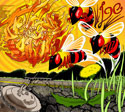 Now they’re back with their second full length. The backstory should give you an idea of their sound. This is an eerie, menacing, hypnotic record, tense like a standoff, explosive like a riot. They’ve finally got the polished production to match their rugged sound: the beats are frenetic and the singing on the hooks is fantastic. They come as relentless as ever with the politics, speaking from where they stand in the heart of anti-capitalist, ecological, and indigenous struggles. The 18 tracks clock in at a full hour–and that sample of Glenn Beck struggling to pronounce their name never gets old. Buy the record here.
Now they’re back with their second full length. The backstory should give you an idea of their sound. This is an eerie, menacing, hypnotic record, tense like a standoff, explosive like a riot. They’ve finally got the polished production to match their rugged sound: the beats are frenetic and the singing on the hooks is fantastic. They come as relentless as ever with the politics, speaking from where they stand in the heart of anti-capitalist, ecological, and indigenous struggles. The 18 tracks clock in at a full hour–and that sample of Glenn Beck struggling to pronounce their name never gets old. Buy the record here.
Also by Test Their Logik
“A” – Their debut album
“Arrested Development” – Their demo tracks
A bonus track with Diverse, not on the album
June 29, 2013
Catharsis Discography Repress and Tour
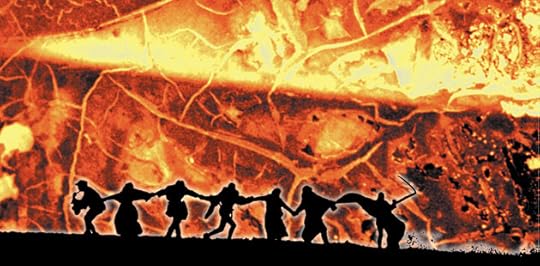
Last winter, we released the Catharsis full discography; it sold out almost instantly. In response to popular demand, we have re-pressed it, this time as two double gatefold LPs with oversize booklets including all the original artwork.

 The first double LP includes the songs from the Samsara LP and debut 7″. The second double LP includes the complete Passion LP, “Live in the Land of the Dead” and “Arsonist’s Prayer” from the split releases, and the final song, “Absolution,” unreleased until the discography.
The first double LP includes the songs from the Samsara LP and debut 7″. The second double LP includes the complete Passion LP, “Live in the Land of the Dead” and “Arsonist’s Prayer” from the split releases, and the final song, “Absolution,” unreleased until the discography.
This time, the band will handle the preorders directly. We are offering a limited run of the records on red-and-black vinyl for $26 each or $50 together (postage paid in the US). Orders are limited to one copy of each double LP per person; they will go out at the end of the summer. If you are only ordering one of the two double LPs, specify which one! If you want to preorder multiple copies, or to order from outside the US, email rollingthunder@crimethinc.com.
This is the Paypal email for ordering: rebellionintomoney@gmail.com
In addition, we have packaged the test pressings from the original run of the discography for record collectors. If you are interested in buying one of these, email rollingthunder@crimethinc.com. Proceeds from these will enable us to fund other projects, which is no easy task in this line of work. If you’re just interested in the songs themselves, the digital download is considerably more affordable.
Finally, Catharsis will be following up on last winter’s reunion shows in the US with a few European shows this summer:
July 27 — Prague/Fluff Fest
August 3 — Refuse Records 20 Year Anniversary Fest Warsaw, Poland
August 4 — Budapest, Hungary
August 5 — Brno, Czech Republic
August 6 — Rote Flora, Hamburg
August 7 — Cassiopeia, Berlin
August 8 — The Winston, Amsterdam
August 9 — La Miroiterie, Paris, France
August 10 — Ieper fest, Belgium
CrimethInc.'s Blog
- CrimethInc.'s profile
- 267 followers









